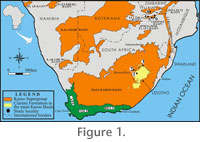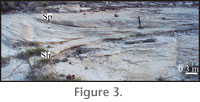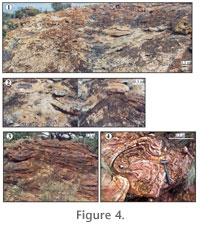| |
INTRODUCTION
 One of the most fascinating geological features of the mainly aeolian Lower Jurassic Clarens Formation of southern Africa (Figure 1) comprises the presence of unbranched, unornamented, cylindrical, exclusively horizontal structures, which show strong compass orientation and locally occur in enormous numbers on weathered surfaces (Figure 2). These bizarre features were first described from the Tuli Basin (South Africa) as Type 2 burrows accompanying some other unusual bioturbation features that were tentatively interpreted as Early Jurassic termite nests (Bordy and Catuneanu 2002;
Bordy et al. 2004). Since this initial discovery, the horizontal, regularly-oriented structures have been observed in numerous other outcrops of the same stratigraphic unit in widely separated regions of southern Africa (Figure 1).
In spite of these large spatial distances, the structures remain consistent in their physical appearance, and occur in clean quartz-arenites, reflecting substrates with homogeneous compositions and textures (Beukes 1970;
Eriksson 1981,
1986;
Johnson 1991, and personal observation). One of the most fascinating geological features of the mainly aeolian Lower Jurassic Clarens Formation of southern Africa (Figure 1) comprises the presence of unbranched, unornamented, cylindrical, exclusively horizontal structures, which show strong compass orientation and locally occur in enormous numbers on weathered surfaces (Figure 2). These bizarre features were first described from the Tuli Basin (South Africa) as Type 2 burrows accompanying some other unusual bioturbation features that were tentatively interpreted as Early Jurassic termite nests (Bordy and Catuneanu 2002;
Bordy et al. 2004). Since this initial discovery, the horizontal, regularly-oriented structures have been observed in numerous other outcrops of the same stratigraphic unit in widely separated regions of southern Africa (Figure 1).
In spite of these large spatial distances, the structures remain consistent in their physical appearance, and occur in clean quartz-arenites, reflecting substrates with homogeneous compositions and textures (Beukes 1970;
Eriksson 1981,
1986;
Johnson 1991, and personal observation).
 The aim of this paper is to present detailed morphologic descriptions, some possible interpretations and geological implications (especially for the predominantly aeolian Lower Jurassic systems of southern Africa) of these unusual structures. This contribution is intended to stimulate the recognition of similar ancient and modern structures worldwide, and to lead to an eventual breakthrough regarding their true genesis. The aim of this paper is to present detailed morphologic descriptions, some possible interpretations and geological implications (especially for the predominantly aeolian Lower Jurassic systems of southern Africa) of these unusual structures. This contribution is intended to stimulate the recognition of similar ancient and modern structures worldwide, and to lead to an eventual breakthrough regarding their true genesis.
Geological Background of the Clarens Formation
The Clarens Formation is a buff-coloured, fine-grained arenite that ranges in thickness from a maximum of about 300 m in the main Karoo Basin, to less than 100 m in the Springbok Flats, Lebombo, Tuli, Tshipise and Ellisras Basins (Figure 1) (Johnson 1994 and personal observation). The gross lithological uniformity of the Clarens Formation led some casual interpretations of the unit (e.g.,
Truswell 1977) as product of an overly dry, sand sea, in spite of detailed investigations (e.g.,
Beukes 1970;
Eriksson 1981,
1986) presenting evidence for episodic wetter phases during the predominant aeolian deposition.
 Throughout southern Africa, the arenaceous Clarens Formation is characterized by massive units interbedded with sandstones (Figure 3) containing small- to very large-scale cross-bedding (planar, trough, low-angle), horizontal lamination, desiccation cracks, etc. (Beukes 1970;
Van Dijk et al. 1978;
Eriksson 1981,
1986;
Bordy and Catuneanu 2002). Evidence of soil formation is virtually absent, with the exception of a single report of rootlets in a silty sandstone facies
in the northeastern main Karoo Basin (Van Dijk et al. 1978). The described horizontal, regularly-oriented structures as well as other associated ichnofossils are preferentially found in structureless, massive facies. Throughout southern Africa, the arenaceous Clarens Formation is characterized by massive units interbedded with sandstones (Figure 3) containing small- to very large-scale cross-bedding (planar, trough, low-angle), horizontal lamination, desiccation cracks, etc. (Beukes 1970;
Van Dijk et al. 1978;
Eriksson 1981,
1986;
Bordy and Catuneanu 2002). Evidence of soil formation is virtually absent, with the exception of a single report of rootlets in a silty sandstone facies
in the northeastern main Karoo Basin (Van Dijk et al. 1978). The described horizontal, regularly-oriented structures as well as other associated ichnofossils are preferentially found in structureless, massive facies.
The Early Jurassic age of the Clarens Formation is based largely on dinosaur biostratigraphy and geochronology of the conformably overlying continental flood basalts, which were dated 183±1 Ma (late Early Jurassic) in the main Karoo Basin (Duncan et al. 1997), and 181-178 Ma in the north (e.g., Tuli Basin) (Le Gall et al. 2002;
Jourdan et al. 2004).
The palaeontological record of the Clarens Formation consists of invertebrate (e.g., crustaceans, insects), vertebrate (e.g., fish, dinosaurs, cynodonts), plant (e.g., sphenophytes, conifers) and numerous ichnofossils (e.g., gastropod trails, arthropod and vertebrate tracks) (Meijs1960;
Beukes 1970;
Ellenberger 1970;
Van Dijk et al. 1978;
Kitching and Raath 1984;
Tasch 1984;
Olsen and Galton 1984;
Smith 1990;
Van Dijk 2001;
Bamford 2004). This palaeontological diversity alone implies that the palaeoenvironments of the Clarens Formation were capable of sustaining, at least episodically, a relatively varied biota, and therefore could have not been overly resource-limited, harsh settings throughout the deposition of the unit. This
interpretation is further corroborated by integrated sedimentary facies analyses (Beukes 1970;
Van Dijk et al. 1978;
Eriksson 1981,
1986;
Eriksson et al. 1994;
Bordy and Catuneanu 2002;
Holzförster 2007), which suggest that the Clarens Formation was deposited in an overall aeolian environment, with wetter interludes during which ephemeral streams, lakes and wet interdune areas existed. The development of this arid to episodically semi-arid setting was most probably linked not only to the Early Jurassic latitudinal position of southern Africa within Gondwana (~45º south –
Veevers 2004), but also to the rain shadow effect of the Cape Fold Belt (Figure 1), which formed a continuous mountain range along the southern margin of the study area.
 The episodic drying and wetting of the climate across southern Africa during this time is substantiated by the large-scale spatiotemporal distribution of wet aeolian conditions in the main Karoo Basin (Beukes 1970;
Eriksson 1981,
1986) and in the smaller basins further north. For instance, in the Tuli Basin (Figure 1), both the lowermost and uppermost parts of Clarens Formation show sedimentary lithofacies indicative of deposition in ephemeral streams and ponds, as well as evidence of plant and animal life (e.g., channel fills, carbonaceous mudstones, coal seamlets, petrified tree trunks with growth rings, vertebrate tracks) (Bordy and Catuneanu 2002; Brandl, personal commun., 2005). Similarly, in the Tshipise Basin (Figure 1), there is evidence showing that the deposition of the aeolian Clarens Formation was also interrupted by wetter intervals, during which the previously deposited sediments became water-saturated. Large- to small-scale soft-sediment deformation features (Figure 4) attest to these water-saturated conditions. These features occur within a 3 m stratigraphical vicinity of the described horizontal, regularly-oriented structures, both in the over- and underlying aeolian strata. The episodic drying and wetting of the climate across southern Africa during this time is substantiated by the large-scale spatiotemporal distribution of wet aeolian conditions in the main Karoo Basin (Beukes 1970;
Eriksson 1981,
1986) and in the smaller basins further north. For instance, in the Tuli Basin (Figure 1), both the lowermost and uppermost parts of Clarens Formation show sedimentary lithofacies indicative of deposition in ephemeral streams and ponds, as well as evidence of plant and animal life (e.g., channel fills, carbonaceous mudstones, coal seamlets, petrified tree trunks with growth rings, vertebrate tracks) (Bordy and Catuneanu 2002; Brandl, personal commun., 2005). Similarly, in the Tshipise Basin (Figure 1), there is evidence showing that the deposition of the aeolian Clarens Formation was also interrupted by wetter intervals, during which the previously deposited sediments became water-saturated. Large- to small-scale soft-sediment deformation features (Figure 4) attest to these water-saturated conditions. These features occur within a 3 m stratigraphical vicinity of the described horizontal, regularly-oriented structures, both in the over- and underlying aeolian strata.
|